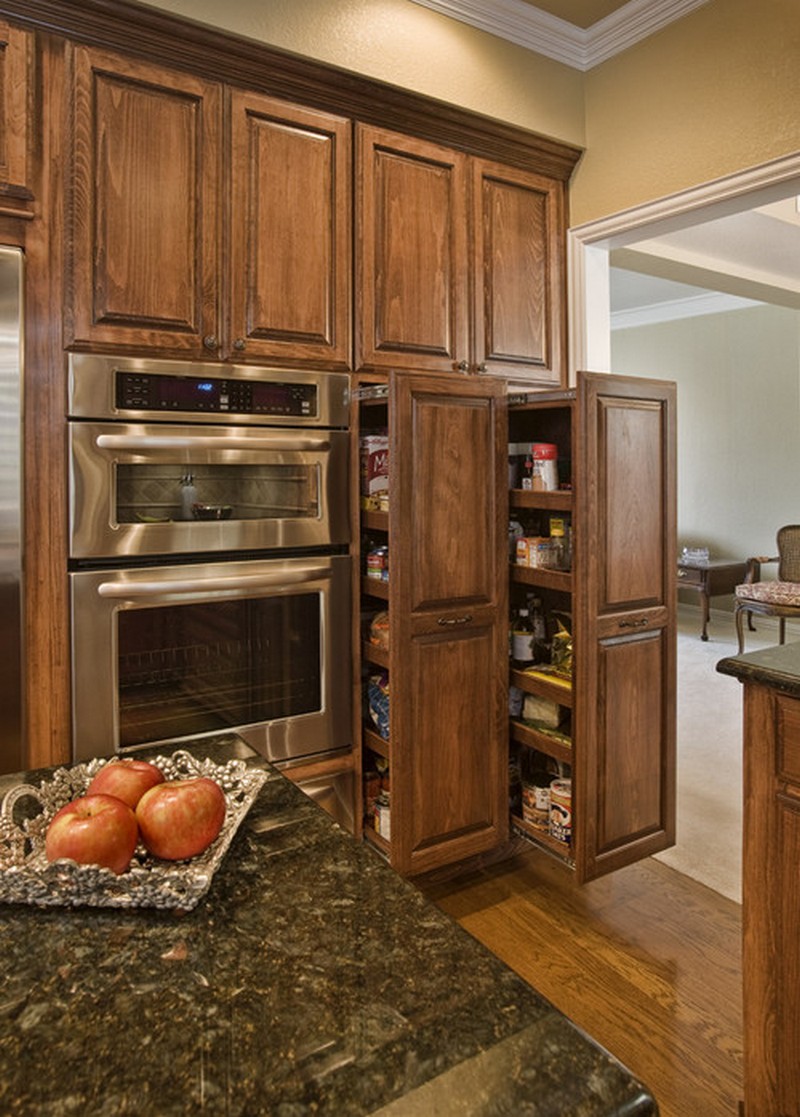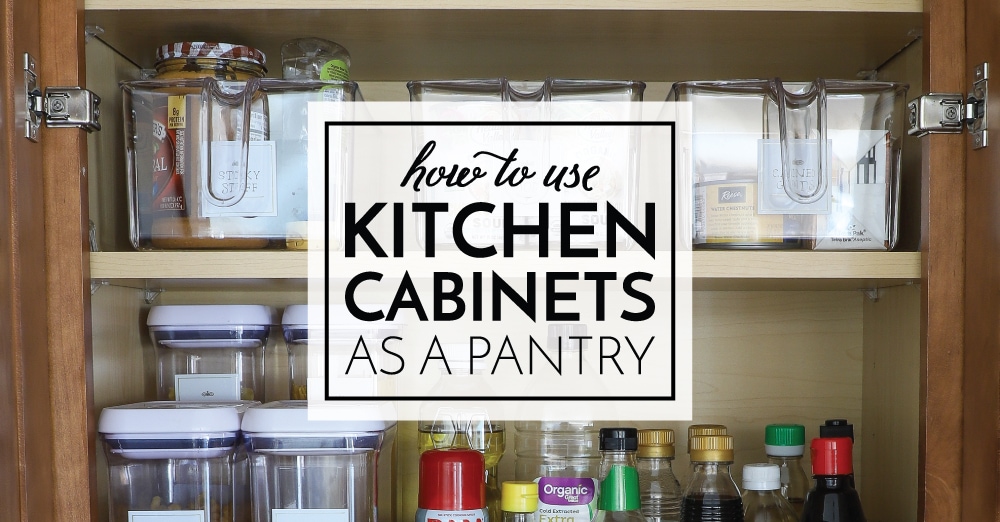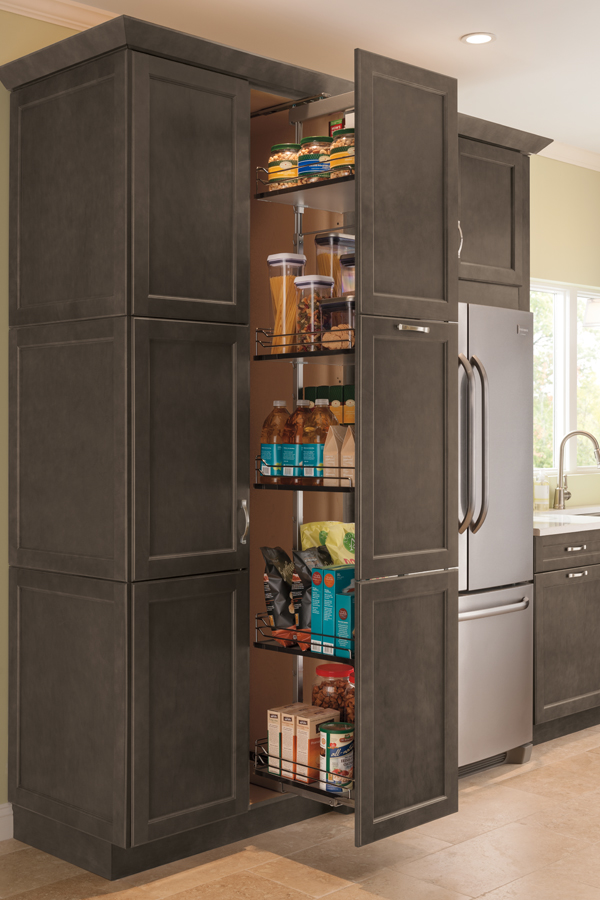Kitchen pantry cabinets are essential elements in modern kitchens, offering organized storage solutions and helping to maintain a clutter-free space. They come in various sizes, designs, and configurations, making them adaptable to different kitchen layouts and storage needs. A well-designed pantry cabinet maximizes vertical space, making it easy to store and access food items, kitchen supplies, and even small appliances. With the growing trend of minimalist and organized kitchen designs, pantry cabinets have become more than just storage; they are an integral part of the overall kitchen aesthetic.
The primary purpose of kitchen pantry cabinets is to provide dedicated storage for non-perishable food items, spices, canned goods, and dry ingredients like rice, pasta, and flour. A properly organized pantry allows you to categorize items, making it easier to find what you need when cooking or preparing meals. Pantry cabinets are particularly useful for storing bulk items, which can be cumbersome to fit into smaller kitchen cupboards. The deep shelves and tall storage spaces typical of pantry cabinets ensure that even large containers and tall bottles can be stored neatly and efficiently.

There are several types of kitchen pantry cabinets, including freestanding pantry cabinets, built-in pantry cabinets, and pull-out pantry cabinets. Freestanding pantry cabinets are versatile and can be placed anywhere in the kitchen, making them ideal for smaller kitchens without built-in storage. Built-in pantry cabinets are integrated into the kitchen’s cabinetry and design, providing a seamless look while optimizing space. Pull-out pantry cabinets, often found in modern kitchen designs, offer easy access to items stored at the back of the cabinet, as the entire shelving unit can be pulled out, revealing everything stored inside.
One of the advantages of pantry cabinets is their ability to improve kitchen organization. With specific areas designated for different types of items, it becomes much easier to keep track of your pantry inventory. This reduces the likelihood of overbuying or forgetting about items that are buried at the back of your shelves. Well-organized pantry cabinets also help minimize food waste, as you can easily see what you have on hand and use items before they expire. Many homeowners invest in additional organization tools such as baskets, bins, and shelf dividers to further enhance the functionality of their pantry cabinets.

Another key benefit of pantry cabinets is that they free up counter space. In many kitchens, countertops can become cluttered with small appliances, food containers, and other items that don’t have a designated storage spot. Pantry cabinets allow you to store these items out of sight, keeping your countertops clear for cooking, meal prep, or other kitchen tasks. Appliances like toasters, blenders, and slow cookers can be easily tucked away in a pantry cabinet, making them accessible but not visible, helping to maintain a clean and tidy kitchen appearance.
The location of your pantry cabinet is another important consideration. Ideally, pantry cabinets should be positioned near the kitchen’s food preparation areas, such as the stove or island, to make it convenient to grab ingredients while cooking. Placing the pantry near the fridge can also be useful, as it allows for efficient movement between storing and accessing perishable and non-perishable items. For larger kitchens, a walk-in pantry may be a viable option, offering an entire room dedicated to food storage and even additional storage for cookware and serving dishes.

When designing a kitchen pantry cabinet, it’s important to consider the shelving layout. Adjustable shelves are a popular option, as they allow you to customize the height of each shelf to accommodate items of different sizes. This is particularly useful for storing tall cereal boxes, large bags of flour, or even small appliances like a stand mixer. Incorporating pull-out shelves or drawers is another excellent way to improve the accessibility of items, especially those stored at the back or bottom of the pantry. These features can help reduce the strain of reaching or bending to retrieve items.
In addition to shelving, incorporating bins, baskets, and clear containers into your pantry cabinet can help keep everything organized. Clear containers are especially helpful for dry goods like pasta, grains, and baking ingredients, as they allow you to see what’s inside at a glance. Labeling containers and shelves is another popular organization tip that ensures you always know where specific items belong. By using uniform storage containers and labeling everything, you can create a visually appealing and highly functional pantry.
Lighting is another crucial aspect of pantry cabinet design that is often overlooked. Proper lighting can make a significant difference in how functional a pantry is, especially in deeper or larger cabinets where items might be harder to see. LED strip lights or puck lights are often installed in pantry cabinets to illuminate shelves and help homeowners quickly find what they’re looking for. In some cases, motion-activated lights are a smart choice, as they automatically turn on when the cabinet door is opened and turn off when it’s closed.

In smaller kitchens where space is at a premium, corner pantry cabinets can be an effective way to maximize storage. These cabinets are designed to fit into the often underutilized corner spaces in kitchens, offering a compact yet spacious solution for storing food items and other kitchen essentials. Corner pantry cabinets can come in a variety of designs, including rotating shelves or pull-out racks, making it easier to access items stored in the deepest parts of the cabinet.
Another trend in pantry cabinet design is the inclusion of built-in organizers, such as spice racks, can holders, and even wine storage. These organizers are built directly into the shelves or doors of the pantry cabinet, allowing for more efficient use of space. For example, a spice rack on the inside of a pantry door provides easy access to frequently used spices without taking up valuable shelf space. Similarly, dedicated can holders allow you to store canned goods in a way that keeps them visible and easily accessible.
Pantry cabinets aren’t just for food storage; they can also be used to store kitchen supplies like dishware, utensils, and even cleaning products. Some homeowners choose to designate sections of their pantry cabinets for these items, creating a multi-functional storage solution that helps reduce clutter in other parts of the kitchen. For example, a top shelf can be used to store extra paper towels or cleaning supplies, while the middle shelves house food items and the bottom shelves hold small appliances or bulk items.

The materials used in pantry cabinet construction can have a significant impact on the look and feel of your kitchen. Wood is a classic and timeless material that can be stained or painted to match your kitchen cabinetry. Laminates and thermofoil finishes are also popular choices for their durability and ease of maintenance. Glass-front pantry cabinets are a stylish option for homeowners who want to display their neatly organized pantry items, adding a touch of elegance and transparency to the kitchen design.
When choosing the right pantry cabinet for your kitchen, it’s important to consider the style and overall theme of your kitchen. If your kitchen has a modern, minimalist design, sleek, handleless pantry cabinets with clean lines and a glossy finish may be the best option. In contrast, traditional kitchens may benefit from more ornate pantry cabinets with raised panel doors and decorative hardware. The choice of cabinet hardware, such as handles and knobs, also contributes to the overall design aesthetic and can serve as a subtle yet impactful design element.
Custom pantry cabinets offer the ultimate flexibility in terms of design and functionality. Custom cabinets can be designed to fit the exact dimensions of your kitchen, ensuring that no space is wasted. This is particularly useful in kitchens with unusual layouts or small, awkward spaces that standard cabinets can’t accommodate. Additionally, custom pantry cabinets can be tailored to your specific storage needs, whether you need more shelves, deeper drawers, or specialized storage for certain items.
Finally, pantry cabinets are an investment in your home that can significantly improve both the functionality and value of your kitchen. A well-organized pantry not only makes meal prep and cooking easier but also enhances the overall appeal of the kitchen, which is one of the most important rooms in any home. Whether you’re planning a full kitchen remodel or simply looking to add more storage to your existing kitchen, a thoughtfully designed pantry cabinet can make a world of difference.

Common Mistakes to Avoid
One common mistake when designing kitchen pantry cabinets is not maximizing vertical space. Tall pantry cabinets often have wasted space between shelves, so it’s important to install adjustable shelving or add additional shelves to make full use of the height available. Another mistake is failing to account for accessibility. Deep pantry cabinets can make it difficult to reach items stored in the back, so incorporating pull-out shelves or lazy Susans can help ensure all items are easy to access.
Another mistake is overstuffing the pantry. While it may be tempting to store as much as possible, overcrowding can make it difficult to see what you have, leading to expired items or wasted food. Instead, prioritize organization and group items into categories to keep things manageable. Additionally, using pantry cabinets for non-kitchen items like cleaning supplies can lead to cross-contamination or confusion. It’s best to keep these items separate to avoid any mishaps.

What are the best materials for pantry cabinets?
The best materials for pantry cabinets depend on your kitchen’s style and budget. Solid wood is a durable and timeless option, while laminates and thermofoil finishes offer easy maintenance and affordability. Glass-front pantry cabinets can add elegance and allow you to display organized items, but they may require more upkeep. Ultimately, the choice of material should balance functionality and design, fitting seamlessly into your kitchen’s overall aesthetic.
How can I organize my pantry cabinet more efficiently?
Organizing a pantry cabinet efficiently starts with grouping items into categories such as canned goods, snacks, baking supplies, and spices. Using baskets, bins, and clear containers can help contain loose items and make them easier to find. Adjustable shelving and pull-out drawers are great additions to maximize space and ensure easy access to items stored in the back. Labeling containers and shelves can further enhance organization and prevent clutter.
Can pantry cabinets be used for more than just food storage?
Yes, pantry cabinets can be used for much more than food storage. Many homeowners use them to store small kitchen appliances, dishware, utensils, and even cleaning products. By dedicating different sections of the pantry to specific items, you can create a multi-functional storage solution that helps reduce clutter elsewhere in the kitchen. Just ensure items are organized and kept in categories to avoid confusion.

What type of pantry cabinet is best for small kitchens?
For small kitchens, a pull-out pantry cabinet or a tall, narrow freestanding pantry cabinet is often the best choice. These designs make efficient use of limited space while offering ample storage. Corner pantry cabinets can also be a great way to maximize often underutilized space. Custom cabinetry may be a worthwhile investment in smaller kitchens, as it can be designed to fit awkward spaces or specific storage needs.
How can I make my pantry cabinet more accessible?
To make a pantry cabinet more accessible, consider installing pull-out shelves or drawers. These allow you to easily reach items stored at the back of the cabinet without having to dig through the front. Lazy Susans are another useful feature for corner pantries, as they allow items to rotate into view. Additionally, adjustable shelving can help you customize the height of shelves to accommodate various item sizes.
How much does a kitchen pantry cabinet cost?
The cost of a kitchen pantry cabinet can vary widely depending on its size, material, and level of customization. Freestanding pantry cabinets are generally more affordable, starting around $200, while custom-built pantry cabinets can cost several thousand dollars depending on materials and design. Built-in pantry cabinets typically fall somewhere in between, with costs influenced by the size, features, and overall kitchen remodel.

bedroom Crockery cabinet design, Kitchen pantry design, Crockery unit design

Pantry wall with counter. 12” depth. Pantry wall, Kitchen wall cabinets, Modern marble kitchen

Related Posts:
- How To Tile A Kitchen Floor Without Removing Cabinets
- Unfinished Kitchen Cabinets To Paint
- Kitchen Cabinets Rhode Island
- Three Drawer Kitchen Base Cabinets
- Kitchen Backsplash Tile With White Cabinets
- Best Shade Of White For Kitchen Cabinets
- Kitchen Cabinet Surfaces
- Second Hand Kitchen Cabinet Doors
- Buy White Kitchen Cabinets
- 64mm Kitchen Cabinet Handles